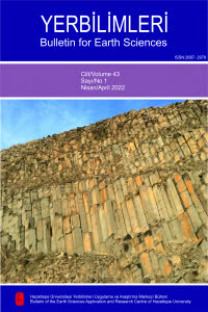Sweep sinyali parametrelerinin korelasyon dalgacığı üzerindeki etkileri
Sweep, Sweep sayısı, Sweep uzunluğu, Pik kuvveti, Vibrator sayısı, Sweep band genişliği.
The effect of sweep signal parameters on correlation wavelet
Sweep, Number of sweep, Sweep length, Peak force, Number of vibrator, Sweep bandwidth,
___
- Anstey, N. A., 1991. Vibroseis. New Jersey Prentice Hall PTR.
- Chapman, W. L., Brown, G. L., and Fair, D. W., 1981, The vibroseis system: A high-frequency tool, Geophysics, 46, No: 12, 1657-1666.
- Chiu, S. K., Eick, P. P., and Emmons, C. W., 2005. High fidelity vibratory seismic (HFVS): optimal phase encoding selection, SEG/Houston 2005 Annual meeting.
- Course Book, 1979. Pelton vibroseis theory training notes, Pelton Company, Inc.
- Crawford, J. M., Doty, W. E. N., and Lee, M.R., 1960. Continuous signal seismograph, Geophysics, 25, No:1, 95-105.
- Cunningham A. B., 1979. Some alternate vibrator signals, Geophysics, 44, 1901-1921.
- Geyer, R. L., 1970. The Vibroseis system of seismic mapping: Canadian Soc. Exploration Geophysicists Jour., v. 6, no. 1, p. 39-57.
- Goupillaud, P. L., 1976. Signal design in the “vibroseis” technique. SEG., Geophysics, 41, No:6, 1294-1304.
- Halliburton Geophysical Services, 1981. Vibroseis Theory and Practice. HGS Manual.
- Klauder J. R., Price A. C., Darlington, S., and Albersheim W. J., 1960. The theory and design of chirp radars. SEG Geophysics Reprint Series, 11, 766-829.
- Lansley, M., 2009. The case for longer sweeps in vibrator acquisition, SEG Houston-2009 International Exposition and Annual Meeting.
- Li, X. P., Sollner, W., and Hubral, P., 1995. Elimination of harmonic distortion in vibroseis data, Geophysics, 60, No:2, 503-516.
- Ugur, F. A. , Turhan, S. , Gören, E. , Gezer, F. , Yegingil, Z. , Sahan, H. , Sahan, M. , Tel, E. And Karahan, G. , 2012, A survey of distribution of terrestrial Radionuclides in surface soil samples in and around the Osmaniye province, Turkey. Radiation Protection Dosimetry (2012), pp. 1–7. doi:10.1093/rpd/ncs259
- Pann, K., 1986. Vibratory signal sweep seismic prospecting method and apparatus, US patent (19), patent number: 4.598.392.
- Rietsch, E., 1977. Computerized analysis of Vibroseis signal similarity, Geop. Pros, 25, 541-552.
- Rietsch, E., 1981. Reduction of harmonic distortion in vibratory source records, Geop. Pros, 29, 178-188.
- Sakallioglu, Y., Gureli, O., and Basar, H. S., 2007. Vibrosismik. Altan Özyurt Matbaacılık Ltd. Şti. Ankara.
- Sallas, J. J., Corrigan, D., and Allen, K. P., 1998. High fidelity vibratory source seismic method with source separation, US patent (19), patent number: 5.721.710
- Sarioglu, A., and Gureli, O., 2005. Parameters affecting amplitudes of wavelet associated with vibroseismic data. 15th International Petroleum and Natural Gas Congress and Exhibition of Turkey (in Turkey).
- Sherrif, R. E., 1990. Encyclopaedic dictionary of exploration geophysics, SEG press.
- Seriff, A. J., and Kim, W. H., 1970. The effect of harmonic distortion in the use of vibratory surface sources, Geophysics, 35, No: 2, 234-246.
- Tantawy, T., and Norotte, C., 1987. Evaluation of risks with vibrators: a preliminary approach, SEG Technical Program Expanded Abstracts 6.
- Thomas, B. J., and Heath, B. J., 1985. Seismic vibrator control system, US patent (19), patent number: 4.493.067.
- Xianguo, H., Shujie, A., Xinquan, W., and Meng, S., 2006. Application of splitting vibroseis sweeps to different VPs in 3-D seismic exploration, New Orleans 2006 Annual Meeting.
- Yildiz, H., Tufan, E. and Çevikbas¸, M., 2003, Osmaniye İlinin jeolojisi, Maden Tetkik ve Arama Genel Müdürlüğü Doğu Akdeniz Bölge Müdürlüğü (in Turkish). http://www.mta.gov.tr/v2.0/bolgeler/adana/bolgesel-jeoloji/jeoloji-osmaniye.pdf, 12.02.2020.
- ISSN: 1301-2894
- Yayın Aralığı: 3
- Başlangıç: 1976
- Yayıncı: Hacettepe Üniversitesi Yerbilimleri Uygulama ve Araştırma Merkezi
Sweep sinyali parametrelerinin korelasyon dalgacığı üzerindeki etkileri
Muğla Fayı, GB Türkiye: Morfometrik, Jeomorfolojik ve Paleosismolojik Yeni Bulgular
M. Korhan ERTURAÇ, H. Serdar AKYÜZ, Aynur DİKBAŞ, Mehran BASMENJİ, Erdem KIRKAN, M. Ersen AKSOY
Hammadde Proses Optimizasyonu ve Çimento Üretimine Etkisi
